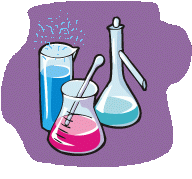


Description of experiment
Below follows a plain text transcript of the selected experiment.
![]()
Needed compounds:
-----------------
sodium fluoride : NaF
sodium chloride : NaCl
sodium bromide : NaBr
potassium iodide : KI
praseodymium chloride : PrCl3
Class:
------
elem=F,Cl,Br,I,Pr
precipitation
coordination
Summary:
--------
Praseodymium (III) ions form complexes with chloride, bromide and iodide. With
fluoride a precipitate is formed.
Description:
------------
Add a lot of solid NaCl to a clear solution of PrCl3 in water: The solid
dissolves and the color of the liquid becomes more intense. It also shifts a
little towards yellow. When most of the NaCl has dissolved, then the liquid has
a fairly bright green/yellow color.
Add a lot of solid NaBr to a clear solution of PrCl3 in water: The solid
dissolves and the color of the liquid becomes more intense and it becomes
yellow. The effect is stronger than with NaCl. Both the intensity of the color
and the shift towards yellow are stronger.
Add a lot of solid KI to a clear solution of PrCl3 in water: The solid
dissolves and the color of the liquid becomes yellow with a slight brown hue.
The effect now even is stronger than with NaBr. Again, both the intensity of
the color and the shift towards yellow are stronger, now the color even is
somewhat brown. With the KI of course there is a possibility that the color
also is due to formation of a little elementary iodine.
Add some solid NaF to a clear solution of PrCl3 in water: The NaF dissolves and
a flocculent white or very light green precipitate is formed.
Remark: Chloride, bromide and iodide form a complex with praseodymium (III)
ions, but a high concentration of the halogenide is needed. Of all solutions,
described above, on dilution the color fades more strongly than expected on the
basis of the dilution.
![]()